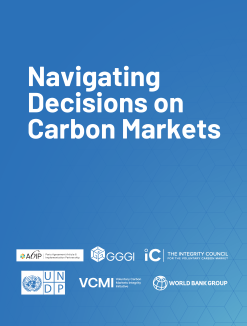
Carbon Credits Market
Carbon Credit Markets
Carbon Credit Markets
Carbon credit markets trade “carbon credits,” which are units that represent an emission reduction, avoidance or removal equivalent to one metric ton of carbon dioxide (tCO2e), generated through voluntarily implemented mitigation activities. Emission reductions can be generated, for instance, by destroying methane generated in landfills. Carbon credits can also represent carbon dioxide removals from the atmosphere, such as sequestering carbon through afforestation or directly capturing carbon from the air and storing it. Demand for credits can come from liable entities meeting compliance obligations (under ETSs or carbon taxes that allow the use of offsets), countries meeting Nationally Determined Contribution (NDC) targets under the UNFCCC, corporates purchasing credits to meet voluntary climate commitments.
As a country considers engaging in carbon markets, it must evaluate several factors including potential revenue generation, co-benefits, and long-term advantages, while weighing these against risks such as failing to achieve NDC targets, socio-economic impacts, and reputational concerns.
In addition, a core enabler of high-integrity carbon markets is the underlying market infrastructure—including registries, MRV systems, and transaction layers—which must be designed with transparency, interoperability, and accountability in mind. For more on these foundational elements, see the Carbon Market Infrastructure resource.
The resources outlined in this page are intended to help decision makers, policy practitioners and stakeholders make an informed choice on these considerations.

Assessing Readiness
The Mitigation Action Assessment Protocol for International Transfer Readiness (MAAP-ITR) tool assists countries in understanding their level of readiness to participate in carbon markets and to facilitate dialogue between entities development partners and national government authorities by identifying key gaps and capacity building needs, thus helping to develop the necessary institutional framework and market infrastructure for effective carbon market participation.
Developing and operationalizing frameworks for carbon market participation requires significant effort. Countries should assess which participation options align best with their national priorities and carbon market profiles, as these will influence the complexity of institutional and policy frameworks.
Guidance for Navigating Carbon Markets
Building on the Navigating Decisions in Carbon Markets framework, this set of Guidance documents supports host countries in developing a strategic approach for engaging with international carbon markets. It is structured around guidance on seven key questions and considerations. The guidance is not prescriptive. Instead, it outlines the pros and cons of different options, highlighting interdependencies and broader implications for carbon market participation. Countries have diverse existing experiences with using international carbon markets. They may therefore wish to refer to specific modules or questions based on their needs. The guidance is intended to be useful and accessible for both countries who are new to international carbon markets and those looking for specialist input on issues. Review the consolidated Country Guidance for Navigating Carbon Markets, or access the individual modules below.
Module 1 supports countries in making an initial decision on whether to participate in international carbon markets as a host country. Understanding the mix of emission reduction and removal (ERR) opportunities, along with their costs and co-benefits, can help determine alignment with international demand. Evaluating how these opportunities fit within the country’s NDC targets and /or Long-Term Low Emission Development Strategy (LT-LEDS) can ensure that credit sales support, rather than hinder, reaching these goals.
Module 2 addresses the core question of whether and when to authorize carbon credits, thereby converting them into Internationally Transferred Mitigation Outcomes (ITMOs). This involves weighing increased market access against the risk of over-selling—a complex and critical decision that many countries seek support to navigate.
Module 3 explores host country options for generating and transferring authorized credits. It covers, for example, options for credit generation, identifying and selecting buyers, and the necessary infrastructure for tracking and reporting authorized credits (ITMOs).
Click here for more on Carbon Market Infrastructure.
Module 4 focuses on credits that host countries decide not to authorize for international transfer. It examines whether host countries might seek to influence whether these credits might be sold to international voluntary buyers of credits, as part of a results-based climate finance (RBCF) arrangement with international development partners, or whether the credits may be retained for domestic use.
Module 5 considers critical policy issues surrounding the international sale of unauthorized credits.
Module 6 provides guidance on using unauthorized credits domestically, particularly in the context of carbon pricing instruments.
Module 7 addresses key cross-cutting issues including, for example, institutional and regulatory frameworks, and how to ensure carbon markets deliver high social value.
